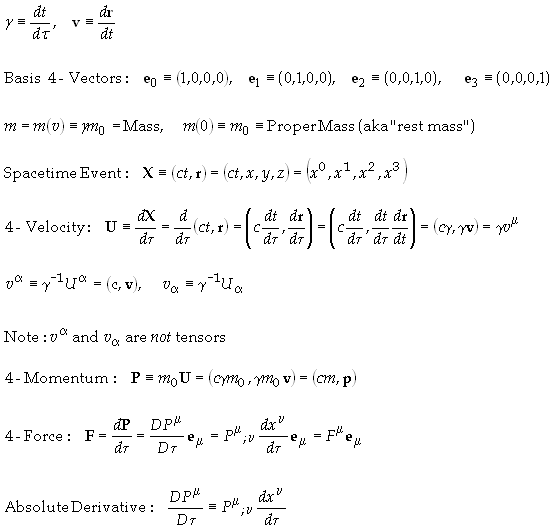
Gravitational
Force
Back
to Physics World
Back to General Relativity
Define
the following quantities

Note:
va
and va
are not tensors, Upper case bold and em are
4-vectors. Lowercase bold and G are 3-vectors.
In what follows it must be kept in mind that “no G’s mean no gravitational force.” This should not be confused with ”G means gravitational force”. The former is always true while the later may or may not be true. For example; if one uses polar spatial coordinates in an inertial frame of reference then there would be non-vanishing G’s but it would not indicate the presence of gravitational forces. An acceleration must represent an actual acceleration rather than a quirk in the coordinate system. For example; if polar coordinates are used and dq/dt is not zero for constant r then this indicates the presence of a force. However if the particle is traveling in a straight line then dq/dt and dr/dt will both be non-zero but no force will be present. Therefore one must be cautious in their interpretation. It is assumed the reader is aware of this fact in what follows.

Rearranging terms we get
![]()
Substituting
![]()
into Eq. (2) gives
![]()
![]()
The first term on the
right side of Eq. (4) is the external applied force. This force moves the
object off of its geodesic and allows it to remain at rest in the gravitational
field (i.e. sitting on the surface of the Earth) rather than remaining in
free-fall. Consider the spatial portion of Eq. (4).
![]()
fk
are the components of the (external) 3-force on the particle. This force will be
denoted from here on as Fex..
The quantity on the left side of Eq. (4) is the total force acting on the object
and denoted as ftotal.
The second quantity on the right side will be denoted as G.
Note:
G is a 3-vector and not the spatial component of any
4-vector.
Therefore we have
![]()
In general relativity,
gravitational effects manifest themselves through the metric tensor gmn. According
to Einstein's Equivalence Principle an accelerating frame of reference is
locally equivalent to a gravitational field. This means that in the absence of a
4-force on particle, the only force acting on the particle will be equivalent to
an inertial force, the force resulting entirely from observing the
particles motion from a frame of reference accelerating with respect to an
inertial frame. Since the first term on the right side of Eq. (4) is
proportional to the 4-force it follows that the second term on the right side of
Eq. (4) represents the gravitational force. Therefore

This is reminiscent of the
covariant form of the Lorentz force, which in Minkowski coordinates, is
given by
![]()
Minkowski coordinates are
employed since we want to compare this with the gravitational force, which is a
force resulting from the use of non-curvilinear spacetime coordinates. Thus we
use the 3-force dp/dt in each. The spatial components can
be written as
![]()
The quantities Fmn are
referred to as the components of the EM field. Similarly the quantities Gakb
are referred to as the components of the gravitational field [Ref 1]. Just as
the EM force is velocity dependent, so too is the gravitational force.
The quantity m therefore plays the role of a gravitational
charge.
The expression for Gk
can be placed in a more familiar form as follows; Rewrite the portion of
gravitational force to the right of the mass as

The kth component
of the gravitational force in Eq. (6) now becomes
![]()
It is shown in the
appendix below that
![]()
Substituting Eq. (11) into
Eq. (8) yields

This relation is reminiscent of the expression for the Lorentz 4-force in terms of the 4-potential Am defined as
![]()
where F
is the Coulomb potential and A is
the magnetic potential 3-vector,. Eq. (10) now becomes

From this it can be seen
that the gravitational force is determined in terms of the derivatives of the
components of the metric tensor gab. Comparing
Eqs. (14) And (16) it follows the metric should be interpreted as a set of ten gravitational
potentials. [Ref. 1] Therefore since the metric is a tensor it is often
referred to as a tensor potential.
If the metric has
constant spatial components (i.e. gij,k
= 0) then we can place Eq. (14) in a more recognizable form. I.e.
![]()
If the gravitational
potential F(r)
is defined as
![]()
then g00
can be written as
![]()
![]()
or in vector notation we
have the final form of the gravitational force (a 3-vector)
![]()
Which is exactly the form of the Newtonian equation with mass replaced by relativistic mass.
Appendix:
Recall the definition of
the Christoffel symbols (of the second kind)
![]()
Multiplying both sides of
Eq. (A1) and contracting over m
gives

Since we want the sum of
two of these terms we change indices to fit the left hand side of Eq. (13). The
first term on the left side is
![]()
The second term of he left
side of Eq. (13) is
![]()
Adding Eqs. (A3) and (A4)
gives, upon canceling a factor of 2
![]()
References:
[1] The
Foundation of the General Theory of Relativity, Albert Einstein, Annalen
der Physik, 49, (1916). An English translation may be found in The
Principle of Relativity, Dover Pub, see page 143.
[2] On the discovery of the gravitational field equations by Einstein and
Hilbert: new materials, V.P. Vizgin, Physics-Uspekhi, 44(12)
1283-1298(2001)